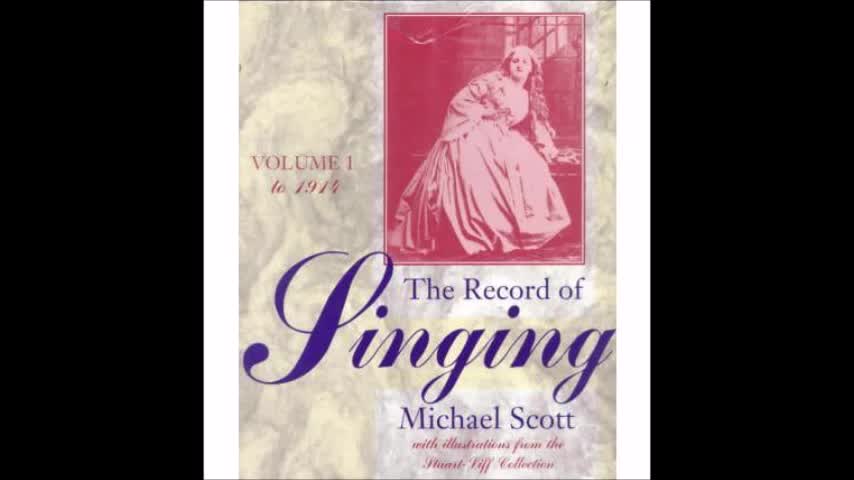Premium Only Content

A Record of Singers (EMI) 1982 Record 7 (Volume 1) Part 2 1899-1919
1 Alessandro Bonci–
Paride E Elena - Spiagge Amate
Composed By – Gluck*
2 Giuseppe Anselmi–
Serse - Va godendo
Composed By – Handel*
*
3 Aristodemo Giorgini–
I Puritani - A Te O Cara
Composed By – Bellini*
Conductor – Carlo Sabajno
4 Edoardo Garbin–
Zaza - È Un Riso Gentil
Composed By – Leoncavallo*
Dramatic Tenors
5 Francesco Tamagno–
Otello - Niun Mi Tema
Composed By – Verdi*
6 Giovanni De Negri*–
Otello - Niun Mi Tema
Composed By – Verdi*
7 Giuseppe Borgatti–
Lohengrin - Atmest Du Nicht
Composed By – Wagner*
8 Fiorello Giraud–
Luisa Miller - Quando Le Sere
Composed By – Verdi*
Piano – Salvatore Cottone
9 Amadeo Bassi*–
Fedora - Amor Ti Vieta
Composed By – Giordano*
Piano – Umberto Giordano
10 Giovanni Zenatello–
Andrea Chénier - Colpito Qui M'avete...Un Di All'azzurro Spazio
Composed By – Giordano*
11 Antonio Paoli–
Otello - Esultate; Ora E Per Sempre Addio
Composed By – Verdi*
Piano – Carlo Sabajno
Caruso
12 Enrico Caruso–
L'Elisir D'Amore - Una Furtiva Lagrima
Composed By – Donizetti*
Piano – Salvatore Cottone
Sopranos Pre-Verismo
13 Ines De Frate–
Lucrezia Borgia - M'odi, Oh! M'odi
Composed By – Donizetti*
14 Elena Theodorini–
Lucrezia Borgia - M'odi, Oh! M'odi
Composed By – Donizetti*
15 Fanny Torresella–
Prendi, Per Me Sei Libero
Composed By – De Bériot*
16 Medea Mei-Figner*–
Queen Of Spades - It Is Midnight
Composed By – Tchaikovsky*
17 Olimpia Boronat–
Olga - E Lo Sapevi
Composed By – Gianelli*
18 Ada Adini–
Hérodiade - Celui Dont La Parole...Il Est Doux, Il Est Bon
Composed By – Massenet*
After Cavalleria
19 Gemma Bellincioni–
Carmen - En Vain Pour Éviter
Composed By – Bizet*
20 Angelica Pandolfini–
Chanson D'Estelle
Composed By – Godard*
Piano – Salvatore Cottone
21 Emma Carelli–
Siberia - Nel Suo Amor
Composed By – Giordano*
The Record of Singing is a compilation of classical-music singing from the first half of the 20th century, the era of the 78-rpm record.
It was issued on LP (with accompanying books) by EMI, successor to the British company His Master's Voice (better known as HMV) — perhaps the leading organization in the early history of audio recording.
The project was accompanied initially by two illustrated books, containing singers' biographies and appraisals, which were published in London, by Duckworth, in the late 1970s. It covers the period running from circa 1900, when the earliest recordings were made, through until the early 1950s, when the last 78-rpm records were produced. Singers are divided into groups arranged according to national 'schools' and fach or voice type. In practice, this means that there are separate Italian, German, French, Anglo-American and East European classifications.
Origins
The original idea for the series came from the collector Vivian Liff, who chose the recordings used in the first two volumes, almost all of which came from the Stuart-Liff Collection, as well as the photographs of the singers which were published in the books that accompanied volumes 1 and 2 of the project. Michael Scott was asked to write these two books. They contained brief singers' biographies, too and featured a critical (sometimes controversial) commentary about their accomplishments, are gleaned from certain discs they had made. Bryan Crimp of EMI was responsible for the transfers of the original recorded material to LP. Keith Hardwick, however, was responsible for the transfers, etc., on the final two volumes of the survey (which were not accompanied by books).
Publication on LPs
EMI first released the collection on vinyl LP (long-playing) records.
Volume 1 first appeared in 1977, with a second edition in 1982 including corrections to the pitch of many of the recordings. The supplement also appeared around 1982. Volume 2 was published in 1979. Volume 3 and Volume 4 were released around 1984 and 1989 respectively.
The complete set was on 47 discs. Volumes 1, 2 and 3 each occupied 13, with Volume 4 having 8 discs. The original intention was apparently to produce 12 LPs per volume; but the selection of singers included in Volume 1 proved controversial, and an extra record (entitled a 'Supplement') was added to partly correct oversights. Volumes 2 and 3 were then assigned 13 records each.
Compact disc.
The collection was published with extensive documentation, including the numbers of the original recordings and full biographies of the singers.
The first two volumes were accompanied by books by Michael Scott:
• The Record of Singing to 1914, London, Duckworth, 1977, ISBN 978-0-7156-1030-5
• The Record of Singing Volume Two: 1914–1925, London, Duckworth, 1979, OCLC 6765624
They were republished in paperback by Northeastern University Press in 1993, ISBN 978-1-55553-163-8
(The books are still widely available from second hand book sellers.)
For more see: The Record of Singing - Wikipedia
-
 1:09
1:09
cwoodvet
5 years agoRBG record part 2
29 -
 1:10
1:10
KMGH
4 years agoA record day
99 -
 LIVE
LIVE
LFA TV
19 hours agoLIVE & BREAKING NEWS! | MONDAY 11/3/25
2,741 watching -
 1:31:18
1:31:18
Graham Allen
5 hours agoErika Fights Back: Vows To EXPOSE TRUTH & DEMANDS Trial Goes Public!! Left Says Her Grief Is FAKE!
146K81 -
 2:08:47
2:08:47
Badlands Media
9 hours agoBadlands Daily: November 3, 2025 – Tariff Wars, SNAP Panic & Brennan Gets Confronted
66.8K17 -
 2:59:32
2:59:32
Wendy Bell Radio
8 hours agoThings Will Get Worse Before They Get Better
92.4K112 -
 1:18:28
1:18:28
The Big Mig™
5 hours agoICE Will Use Private Bounty Hunters, LFG
37.6K13 -
 1:08:17
1:08:17
Chad Prather
12 hours agoHow to Get Along With People You Don’t Even Like (Most of the Time)
126K34 -
 1:45:29
1:45:29
MTNTOUGH Podcast w/ Dustin Diefenderfer
11 hours agoTaya + Colton Kyle: Can American Marriages Survive 2025? | MTNPOD #140
32.1K -
 1:12:23
1:12:23
MikeMac - Say Something
19 hours agoSay Something Beyond W/MikeMac: JOKER - Ep.12
29.6K1